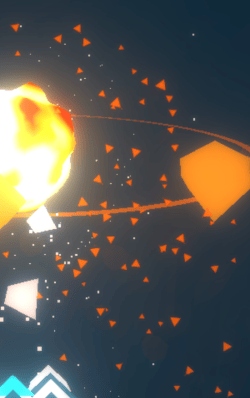2. Making a Small Library for particles animation!
This article is part of a series, here are all the other articles:
- Part 0: Introduction
- Part 1: Shaders: displacement map and Bloom
- Part 2: Making a Small Library for particles animation ⬅️
- Part 3: Making Things Easier with Coroutines
In this article, I’ll talk about particles and a little library I made for particles and emitters management. I love particles! They’re used for many effects in this project, like static stars, trails, and explosions.
-
Particle Systems in ECS: We handle particles using the Entity Component System (ECS)1 principle. We have particle emitters (Components), and a particles system (System) that manages the life cycle of the particles and emitters. For example, if we want the ship to have a trail of particles, we simply add a trail component to the ship entity.
-
Performance Challenge: A big issue was dealing with many particles being created and destroyed. This process was heavy on performance, causing slowdowns mostly due to the garbage collector. To fix this, I optimized how particles are handled to reduce the workload on the game’s engine.
-
Emitter Features: Emitters have several settings like the shape (
dot,squareortriangle), system size, and maximum number of particles. There are also settings for each particle, like size evolution (size_start,size_end) and color (color_start,color_end). The emitting behavior includes settings likecount_per_sandinitial_visibles. Here’s an example of how an explosion is created:
static createExplosion() {
return {
type: 'Trail',
behavior: 'explosion',
shape: 'tri',
system_size: 6,
count_per_s: 0,
initial_visibles: 120,
decay: 0.96,
life: 1.2,
size_start: 6,
size_end: 0,
velocity: 400,
color_start: Palette.red,
color_end: Palette.light
}
}
-
Updating Particles: The ParticleSystem updates all particles and emitters. For example, the
updateParticle()function handles the changes to each particle. -
Particle Features: Particles have attributes like shape, color, and position. When a particle is ‘dead’, it’s not displayed but is kept for recycling, which helps with performance.
-
Rendering Particles: In the vertex shader, we define how the particles appear in 3D space. The size adjusts based on their distance to the camera. The final appearance is determined in the fragment shader, where we apply textures and colors.
v_color = (hidden < .5) ? vec4(color, 1.) : vec4(0.);
v_angle = angle;
vec4 pos = modelViewMatrix * vec4(position, 1.);
gl_PointSize = (u_size + size) * (300. / length(pos));
gl_Position = projectionMatrix * pos;
float c = cos(v_angle);
float s = sin(v_angle);
vec2 p = gl_PointCoord - .5;
vec2 rotated_uv = vec2(
(c * p.x + s * p.y) + .5,
(c * p.y - s * p.x) + .5
);
vec4 tex_color = texture2D(u_texture, rotated_uv);
gl_FragColor = tex_color * v_color;
This approach allowed me to create dynamic, visually appealing particle effects efficiently, adding depth to the game’s environment.

In the next article I’ll talk about coroutines, and how to use them in a game. Thanks for reading and see you!